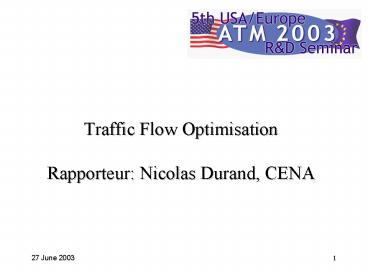Traffic Flow Optimisation Rapporteur: Nicolas Durand, CENA - PowerPoint PPT Presentation
1 / 19
Title:
Traffic Flow Optimisation Rapporteur: Nicolas Durand, CENA
Description:
limit the number of conflicts by optimising the route and flight level. ... Quality of the optimization relies on valid assumptions ... – PowerPoint PPT presentation
Number of Views:76
Avg rating:3.0/5.0
Title: Traffic Flow Optimisation Rapporteur: Nicolas Durand, CENA
1
Traffic Flow OptimisationRapporteur Nicolas
Durand, CENA
2
Thanks
- Thanks to the reviewers
- Tom Edwards
- George Donohue
- Heinz Winter
- Thanks to the chairmen
- Jean-Marc Pomeret
- Alain Printemps
- A special thanks to Christian, Sabrina and
Catherine
3
9 out of 16 papers accepted
- 4 papers from Europe
- Eurocontrol (EEC)/Transim/Modis
International/Neosys - Eurocontrol (EEC)/Université Technologique de
Compiegne (UTC) (2 papers) - NLR
- 4 papers from USA
- Metron Aviation/University of Colorado/University
of Maryland - Boeing ATM
- Metron / FAA
- NASA (ARC)
- 1 Europe-USA paper FAA/ISA Software
4
Participation to presentations
5
Themes covered
- Analysis of the existing system behaviors
- A study of the NAS Behavior (ETMS Scheduled Route
Errors) - higher view of the NAS system (get away from
tools) - debate on the prediction accuracy problem
- Comparison between pilot models and humans in
an autonomous aircraft environment. - Effects of human in the loop (complex conflicts)
- debate on the conditions of the experiments (low
participation, toy problems)
6
Themes covered
- Ground Delay Equity
- limit inequities rising from exempted flights and
mitigate the resulting bias - questions on uncertainties, acceptation by
airlines, extension to holding - Route flight level assignment
- limit the number of conflicts by optimising the
route and flight level. Good modeling and strong
algorithm. Connexions with telecom problems - questions on uncertainties, sector capacity
respect, cost criteria, overtaking aircraft
7
Themes covered
- Airline Schedule Recovery
- Precise modeling of the problem, experiments on a
simplified environment on real data - Questions on the algorithm used, the complexity,
assumptions - Sectorization optimization with constraints
- CSP modeling of the Sector design problem.
- Questions on constraints assumptions, sensitivity
to parameters, 3D extension - Conceptual approach of SuperSectors
- A new organization of controllers tasks to
optimize capacity - Debate on the role of each layer, efficiency of
control by exception
8
Themes covered
- Trajectory Optimization
- Real Time Conflict-Free Trajectory Optimization
- Based on the sparse aispace assumption, perturb
the unconstrainted trajectory using a conflict
grid. - Questions on uncertainties on detection
resolution, how often should the optimization be
updated - Dynamic Re-routing
- RAMS algorithm on US data, trajectory rerouting
when delay is important enough. - Questions on the OPGEN algorithm, partial
information influence on result, uncertainties
impacts
9
Algorithms used
- CSP (Constraint Satisfactory Programming)
- Integer Linear Programming
- Optimal Control Techniques
- Lagrangian Relaxation techniques
- Genetic Algorithms (OPGEN)
- Modified Voltage Potential methods
- ...
10
Rapporteurs comments
11
Still different environments
- USA
- 1 constraint/bottleneck at a time (Ground delay
equity) - Mostly airport weather problems (Dynamic
rerouting, airline schedule recovery) - En route capacity not crucial (Real time conflict
free) - Equity is already an issue (Ground delay
equity) - Europe
- Several constraints at a time (Route FL
assignment) - Mostly en-route problems (Route FL assignment,
optimized sectorization) - High densities (bots/human comparison)
- But a better understanding of each others
problems
12
Impact on the optimisation methods
- USA
- Easier to separate problems
- Local optimisation methods
- Longer horizon (optimisation of the full
trajectory) - Europe
- Global treatment of problems
- Combinatorial optimisation
- Shorter horizons
13
Shared concerns (1)
- You cannot optimize without a proper description
of the context - Quality of the optimization relies on valid
assumptions - Difficult to enter the ATM world for newcomers
- Need for specific community efforts
14
Shared concerns (2)
- There is a need of accurate prediction (for each
presentation questions on uncertainties) - Trajectory prediction
- Flight information, weather forecast accuracy
- Eliminate uncertainties or deal with them?
- Stochatic model or exact model ?
- Where is the trade-off (uncertainty-time
horizon) ?
15
Rapporteurs recommandations
16
To authors
- Scientific Approach
- need to explain more precisely what is behind
algorithms (no progress possible with
proprietary approaches or blackboxes ) - An opinion is not a proof (be careful with
conclusions) - Need for details on
- assumptions, parameters
- algorithm complexity, computing time
- Bibliography
- improve -) Some papers still rather poor on
bibliography
17
Recommandations
- To the ATM RD community
- Necessary steps towards better collaborations
- Share data, benchmarks or even toy problems
- Cross-test results on each-others simulators
- To the RD Committee
- Give more information to the authors when their
papers are rejected - Improve paper allocations to the tracks.
- Encourage more collaboration with Universities
18
My conclusions
- We move forward (but very slowly ? )
- Some very complete state of the art in papers
- with mixed references of what is done both sides
- The ATM RD Proceedings are widely used
- The evolution since Saclay 97 is important
- As an example thanks to previous ATM RD
Seminar, we expect to present results of
comparisons on Traffic complexity using US
European data with the same tool at the next ATM
RD Seminar
19
Back to work !































